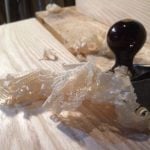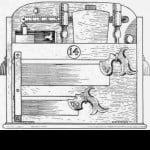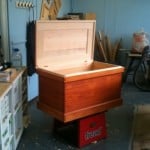Best way to end-join boards for tabletop
Welcome! / Forums / General Woodworking Discussions / Wood and Wood Preparation / Best way to end-join boards for tabletop
Tagged: scarf splice
- This topic has 13 replies, 9 voices, and was last updated 9 years, 9 months ago by
 Jim Allen.
Jim Allen.
-
AuthorPosts
-
17 March 2014 at 5:06 pm #28993
Hi all,
I’m after a bit of advice: my father-in-law has given me a load of old elm floorboards that he has ripped up from his old barn. Most are in good condition and I would like to make a dining table with them. They are about 1″ thick and cut into lengths roughly 3-4′ long. I am happy edge joining the boards, but I also want to end join them (along the end grain) to give me a longer table.
What’s the best way to achieve this that will be strong enough for a dining table? I am planning to stagger the end joints to maximise stability from the surrounding boards, but am worried about the strength of the end joints.
Any advice appreciated!
Cheers,
Chris
I think the biggest part of the issue is getting them square in all it’s relative ways.
A well executed shooting board and well set plane will get that done up relatively quick, I suppose you could use a sort of mortise and tenon (floating, or drill holes in both ends and use a dowel pin). Or suggest a half lap type joint using a router plane to keep your depth consistent. Either Should create a strong joint to help keep your plates off your lap.
Brian
From my reading (not experience), a splice or scarf joint is the appropriate way to extend lumber with a good amount of strength. There are many variations of these joints, some which are more elaborate and have locking keys. Others are simpler and are not much more than a sloping half-lap, where the slope is 6-8 times the thickness of the board. Strength is supposedly far superior to a simple half-lap.
I would really love to see someone using this joint. I think they are largely used in carpentry and boat building, but I do not remember seeing one used in furniture. I suppose machined finger joints have largely replaced the scarf joint these days.
What about a staggered layout of the boards? That way you’d be joining long grain to long grain mostly. Then you’d have end grain to end grain on only small areas but it wouldn’t need to be as strong a joint.
That is assuming you don’t want an exact multiple of your shorter boards.Diego
18 March 2014 at 8:37 pm #29011Thank you all for your answers.
Diego – I did wonder about just staggering the boards; I guess the long grain glued joints would give it plenty of strength.I think I might try some experiments with the lap joints suggested by Brian and Scott – the sloping lapped joints could end up being quite a lot of work though without any table saw, but then this forum is all about hand tool working!
Anyhow – most of the hard work is going to be just getting all the boards flat and square, as Diego alluded to!
Cheers all.
Chris, Exeter. UK.


 13 April 2014 at 6:57 pm #56075
13 April 2014 at 6:57 pm #56075Thanks Michael – I like that idea. I’m currently feeling a bit daunted by the large amount of work that is required to plane and square all the boards with just hand tools! Good practice I suppose!

What you are looking to do has been done many times before. I would construct it like a very long frame and panel door with more than one cross-members. You could leave off the stiles if you wish. Making the panel pieces flush with the frame would be the way to go.
14 April 2014 at 6:41 pm #56144Hmmm – interesting idea. I had not thought of that. That would be a good way to make it splittable too in the middle to add an extra section for extending it. Thanks!
I was recently in an indigenous village in the amazon river basin. They used a lot of the scarf/splice joints. They had very limited tools and an abundance of dense wood (we call that exotic wood). The joints were used in the rafters and even the ridge pole as well as benches.
-
AuthorPosts
- You must be logged in to reply to this topic.
